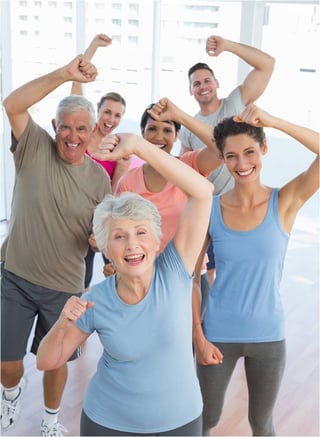 Exercise, as we know, is an essential part of living a healthy life—not only for the elderly, but for everyone. One common question I get is, “What exercises should I do?” Now, this is a loaded question. That’s going to depend on things like goal, fitness level, capability, and injury. But for the most part, I recommend that everyone follow basic guidelines for success when it comes to their fitness. Over the course of this blog, I discuss two of my guidelines for fitness. Not everyone is the same; therefore, one size doesn't fit all. But we are all humans, so one size does fit most.
Exercise, as we know, is an essential part of living a healthy life—not only for the elderly, but for everyone. One common question I get is, “What exercises should I do?” Now, this is a loaded question. That’s going to depend on things like goal, fitness level, capability, and injury. But for the most part, I recommend that everyone follow basic guidelines for success when it comes to their fitness. Over the course of this blog, I discuss two of my guidelines for fitness. Not everyone is the same; therefore, one size doesn't fit all. But we are all humans, so one size does fit most.
When asked about what style of fighting he instructs and follows, Bruce Lee, my hero and inspiration, responded: “I don't believe in different ways of fighting now. I mean, unless human beings have three arms and three legs, then we will have a different way of fighting. But basically we all have two arms and two legs, so that is why I believe there should be only one way of fighting and that is no way.” Essentially, he was saying what I said before, which is that even though we are all different and everything doesn't apply to everyone, we are all more similar than we are different; therefore, the same basic rules will apply to everyone, whether it's with martial arts or exercise.
Guideline 1: Muscle-Activation Exercises
Muscle activation is when someone gains mastery over his or her body. A good example would be a bodybuilder. A bodybuilder will get on stage and brace their muscles as a means of showing their physique, but tensing that muscle tissue allows them to make that “mind-muscle connection,” which will allow them to concentrate on that particular muscle while doing an exercise. Essentially, they have an uber-awareness of their bodies.
Simple exercises isolating each muscle group through bracing can be a huge help in achieving this awareness. Also, certain exercise tips can increase this. For example, when performing a seated row, you want the client to concentrate on rowing with the upper back and not the arms; therefore, you can give them a simple cue such as pretending to squeeze an imaginary tennis ball together with their shoulder blades. This cue will allow them to take tension off certain areas, such as the arms, and put more tension on those larger, postural muscles like the lats, rhomboids, and traps.
Guideline 2: Simplistic Exercises
Simplicity with exercise is an important key to success. The more complex and drawn out the exercise becomes, the less the client will think about muscle activation and the more they will think about how confused they are. When describing his art, Jeet Kune Do, Bruce lee stated, “Simplicity is the key to brilliance. In building a statue, a sculptor doesn't keep adding clay to his subject. Actually, he keeps chiseling away at the inessentials until the truth of its creation is revealed without obstructions. Thus, contrary to other styles, being wise in Jeet Kune Do doesn't mean adding more; it means to minimize, in other words to hack away the unessential.”
Subscribe to our blog by clicking below to receive new blog posts directly to your inbox.

